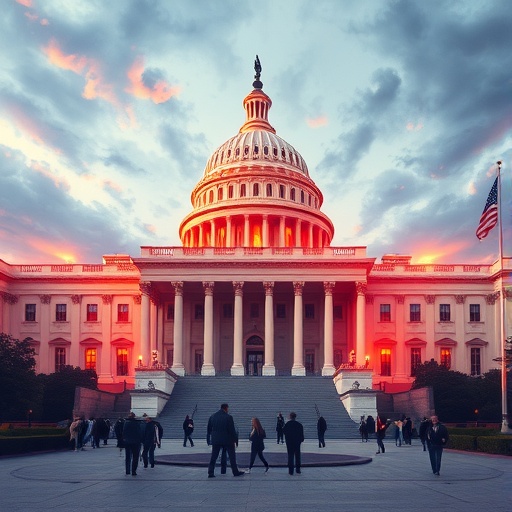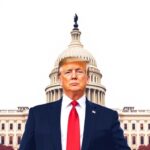US Government shutdown Ignites Constitutional Clash Over Spending Power and Federal Funding
In a dramatic escalation of political tensions, the US Government shutdown has plunged federal operations into chaos, freezing billions in federal funding and sparking a fierce debate over whether President Trump is eroding Congress’s constitutional authority over spending. As lawmakers from both parties scramble for a resolution, the impasse highlights a deepening power struggle between the legislative and executive branches, with everyday Americans bearing the brunt of delayed services and unpaid workers.
- Federal Funding Freeze Leaves Millions in Uncertainty
- Trump’s Aggressive Push Challenges Congressional Spending Authority
- Congressional Leaders Clash in High-Stakes Negotiations
- Constitutional Experts Sound Alarm on Executive Overreach
- Path Forward: Resolving the Shutdown and Safeguarding Spending Power
The shutdown, now in its third day, stems from disagreements over a massive spending bill that includes provisions for border security and domestic programs. With over 800,000 federal employees furloughed and critical services like national parks and food safety inspections halted, the stakes couldn’t be higher. Critics argue that Trump’s insistence on tying federal funding to his policy priorities is not just a negotiation tactic but a direct challenge to Article I of the Constitution, which grants Congress the exclusive power of the purse.
This isn’t just bureaucratic gridlock; it’s a constitutional crisis in the making. As one senior lawmaker put it, “We’re witnessing an unprecedented assault on the checks and balances that define our democracy.” With the economy teetering and public frustration mounting, the battle over spending power could redefine the balance of authority in Washington for years to come.
Federal Funding Freeze Leaves Millions in Uncertainty
The immediate fallout from the Government shutdown has rippled across the nation, grinding federal funding to a halt and affecting everything from veterans’ benefits to air traffic control. According to the Office of Management and Budget, the shutdown could cost the economy up to $1.2 billion per day, with federal funding for over 40 agencies completely stalled. National parks, such as Yellowstone and the Grand Canyon, have shuttered their gates, turning away thousands of visitors and local businesses that rely on tourism revenue.
At the heart of this disruption is the standoff over a $1.3 trillion omnibus spending package that Congress failed to pass before the midnight deadline. Federal employees, from IRS auditors to Smithsonian curators, are facing unpaid wages, with many dipping into savings or seeking emergency loans. “I’ve served my country for 15 years, and now I’m wondering how I’ll pay my mortgage,” said Maria Gonzalez, a furloughed National Park Service ranger in California. Her story echoes the plight of countless workers whose livelihoods hang in the balance due to this funding freeze.
Beyond the human cost, the shutdown exposes vulnerabilities in essential services. The Department of Agriculture has halted inspections for meat and poultry, potentially leading to supply chain disruptions. Meanwhile, the Small Business Administration’s loan programs are on ice, stifling growth for entrepreneurs at a time when the economy is showing signs of slowdown. Economists warn that prolonged delays in federal funding could shave 0.5 percentage points off GDP growth in the first quarter, according to a recent Brookings Institution report.
States are stepping in where they can, but the patchwork response underscores the irreplaceable role of federal funding. In New York, Governor Andrew Cuomo announced state funds to keep some federal programs afloat, but experts say this is merely a band-aid. The shutdown’s timing, just months after the midterm elections, amplifies partisan divides, with Democrats accusing Republicans of caving to Trump’s demands on spending power.
Trump’s Aggressive Push Challenges Congressional Spending Authority
President Trump has emerged as the central figure in this government shutdown, using his platform to demand concessions on border wall funding as a condition for restoring federal funding. In a fiery tweetstorm late last night, Trump declared, “Congress must secure our borders before any deal on spending. The American people deserve safety, not endless debates.” This stance has intensified concerns that he is attempting to bypass Congress’s spending power, a move constitutional scholars liken to executive overreach.
Trump’s strategy builds on his long-standing criticism of congressional gridlock, positioning the shutdown as a necessary evil to force action on immigration. During a White House address, he outlined plans to redirect existing federal funds toward border security, a tactic that legal experts say treads dangerously close to violating the Impoundment Control Act of 1974, which prohibits presidents from withholding congressionally appropriated funds without approval.
Supporters of Trump argue that his approach is a bold exercise of executive prerogative in the face of legislative inaction. House Majority Leader Kevin McCarthy praised the president’s resolve, stating, “For too long, Congress has abdicated its responsibilities. President Trump is leading where others won’t.” Yet, this defense only fuels the narrative of a power shift, with Trump’s administration exploring emergency declarations to unlock funds independently.
Historical context reveals Trump’s pattern: In 2018, a similar shutdown over border funding lasted 35 days, costing $11 billion. Now, with midterm gains for Democrats in the House, the dynamics have shifted, but Trump’s unyielding position on spending power suggests he’s willing to prolong the crisis. Polls from Gallup show his approval rating dipping to 42% amid the chaos, yet he remains defiant, framing the government shutdown as a fight for national security over partisan bickering.
Congressional Leaders Clash in High-Stakes Negotiations
Inside the halls of Congress, the government shutdown has triggered intense negotiations, with leaders from both chambers locked in marathon sessions to reclaim control over spending power. Senate Minority Leader Chuck Schumer lambasted the impasse, saying, “This shutdown is President Trump’s doing, an attempt to bully Congress into submission on federal funding.” Democrats, holding a slim majority in the House, are pushing for a clean continuing resolution to reopen the government without concessions on the border wall.
Republicans, however, are divided. While some, like Senator Lindsey Graham, align with Trump, others express frustration over the erosion of congressional authority. “We can’t let the executive branch dictate spending; that’s our constitutional duty,” remarked Representative Justin Amash, a vocal critic within the GOP. The House Freedom Caucus has emerged as a wildcard, threatening to withhold support unless spending cuts are included, complicating the path to agreement.
Key sticking points include the $5.7 billion Trump seeks for the wall, juxtaposed against Democratic priorities like disaster relief for hurricane-hit regions. A recent CBO analysis estimates that unresolved federal funding issues could delay $20 billion in infrastructure projects. Bipartisan talks broke down yesterday when Trump walked out of a meeting, citing “fake news” reports on the negotiations.
Women in Congress are particularly vocal, with Representative Nancy Pelosi, poised to become Speaker, emphasizing the human impact. “Families are suffering because of this reckless game over spending power,” she said in a floor speech. As the shutdown drags on, procedural votes in the Senate could force a resolution, but with filibuster threats looming, unity remains elusive.
Constitutional Experts Sound Alarm on Executive Overreach
The government shutdown isn’t just a political headache; it’s igniting a profound constitutional debate about the balance of spending power between branches. Legal scholars warn that Trump’s tactics could set a precedent for future presidents to sideline Congress, fundamentally altering federal funding mechanisms. Elizabeth Wydra, president of the Constitutional Accountability Center, stated, “Article I is clear: Congress controls the purse. Any attempt to undermine that invites authoritarian drift.”
Drawing parallels to the Nixon era, when impoundment powers led to reforms, experts highlight how modern shutdowns have become tools for executive leverage. A study by the American Political Science Association notes that shutdowns have occurred 21 times since 1976, but none have so explicitly challenged spending power as this one under Trump. “We’re seeing a reconfiguration of power,” said Professor Norman Ornstein of the American Enterprise Institute. “Congress must assert itself or risk irrelevance.”
Public opinion reflects these concerns: A Pew Research poll found 54% of Americans blame Trump for the shutdown, with 68% viewing it as harmful to the economy. Advocacy groups like the ACLU have filed briefs arguing that withholding federal funding violates separation of powers. Meanwhile, conservative think tanks such as the Heritage Foundation defend Trump’s position, claiming it’s a response to congressional dysfunction.
The debate extends to international implications, as allies question US stability. European diplomats have expressed worry that prolonged uncertainty over federal funding could weaken America’s global standing. Domestically, faith in institutions is eroding, with trust in government at historic lows per Edelman Trust Barometer.
Path Forward: Resolving the Shutdown and Safeguarding Spending Power
As the government shutdown enters uncharted territory, eyes are on upcoming deadlines that could either break the deadlock or extend the pain. Congress faces a January 15 debt ceiling cliff, compounding pressures on federal funding and forcing lawmakers to confront the spending power divide head-on. Bipartisan working groups are forming, with Speaker-designate Pelosi signaling willingness for compromise if Trump eases demands.
Potential resolutions include a short-term funding bill to avert immediate catastrophe, followed by comprehensive reforms to prevent future shutdowns. Proposals like automatic continuing resolutions, floated by Senate moderates, aim to protect essential services while preserving congressional authority. Trump has hinted at flexibility, tweeting, “Let’s make a deal that’s good for America,” but skeptics doubt his sincerity without concessions.
Long-term, this crisis could spur constitutional amendments or legislation strengthening Congress’s spending power, such as enhanced oversight on executive impoundments. Economists project that a swift resolution might limit damage to $6 billion, but delays could balloon costs exponentially. For affected workers, relief funds are being discussed, with states like California allocating $100 million in aid.
Ultimately, the shutdown’s legacy will hinge on whether Congress reasserts its role or cedes ground to the executive. With public pressure mounting—protests planned in major cities—and midterm mandates fresh, the battle over federal funding and spending power may catalyze a return to principled governance. As one veteran senator noted, “This is a defining moment for our republic; we can’t afford to get it wrong.”









